

The Critical Power Supplement
Energizing tomorrow’s data centers
Nuclear option: >Colocating with power plants
Growing capacity:
>Using AI to improve the grid
Free flowing: >Flow batteries and data centers

Power quality solutions engineered to prevent data center downtime
Voltage sags and harmonics are the leading threats to uptime. Schneider Electric’s PowerLogic™ DVR and PowerLogic™ AccuSine PCS Plus deliver precise power correction and ensure compliance to IEEE 1668 and IEEE 519 standards.
Boost resilience. Protect equipment. Stay operational.
Contents
4. Colocation Meets Regulation
The what and why behind FERC’s rejection of AWS and Talen’s behindthe-meter agreement
8. Quality issue
Why power quality is the unsung hero of the AI-driven data center
10. From Years to Months
Creating an AI fast lane for grid connection
14. Go with the Flow Are flow batteries the answer to the energy storage needs of data centers?
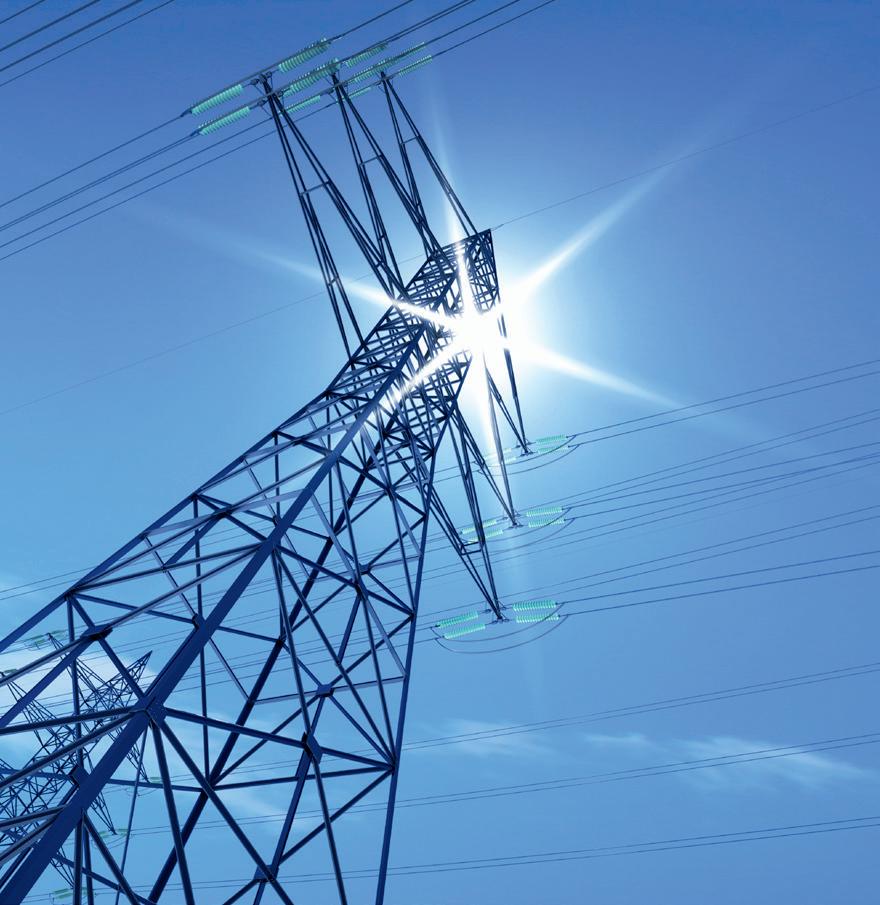

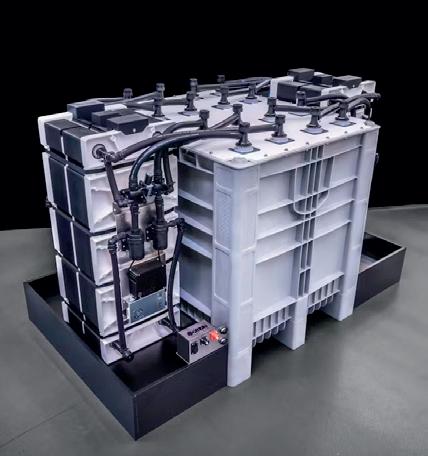
Powering up
As the era of the gigawatt data center approaches, securing a reliable power grid connection has never been more critical.
Global electricity consumption from data centers is projected to more than double, according to a recent International Energy Agency (IEA) report, with AI cited - perhaps unsurprisingly - as the major driver.
The IEA report projects that data center consumption globally will grow to 945TWh per year by 2030, from 415TWh in 2024.
With this in mind, the fight for energy resources is likely to ramp up in the coming years, so operators are looking for novel solutions.
Colocating data centers at power stations has been touted as one potential solution, with behind the meter agreements potentially allowing firms to access power directly from the source before it even hits the grid.
However, one attempt to set up such an arrangement, AWS’s plan to take power from Talen’s nuclear plant in Pennsylvania, US, to supply a newly-acquired has run into regulatory difficulties. Zach Skidmore takes a closer look at the problems that occur when colocation meets regulation.
Elsewhere, AI could also be part of the solution, with several companies developing solutions
that deploy artificial intelligence to look for areas where the grid could get more efficient. In this supplement, we profile one of these companies, GridCARE, an US vendor using AI to map available grid assets that can be used to relieve constraints in real time. By combining grid data, asset visibility, and scenario modeling, the company believes it can unlock significant extra capacity.
As more and more renewables come into play in power systems across the world, battery energy storage systems, better known as BESS, are becoming a staple of new data center designs. BESS enable energy to be stored so that it can be used at times when the sun isn’t shining or the wind has dropped.
While the need for BESS is not disputed, the type of battery that should sit at the center of these systems is up for debate, with the dominant lithium-ion chemistry not necessarily the most suitable for the task, not least because a fire or explosion could have big implications when these batteries are located in multi-billion dollar developers.
A growing number of vendors believe liquid flow batteries could be a safer, more efficient alternative to lithium-ion for data centers, but, as we discover, significant hurdles must be overcome if they are to become a commercially viable option in the digital infrastructure space.
Colocation Meets Regulation

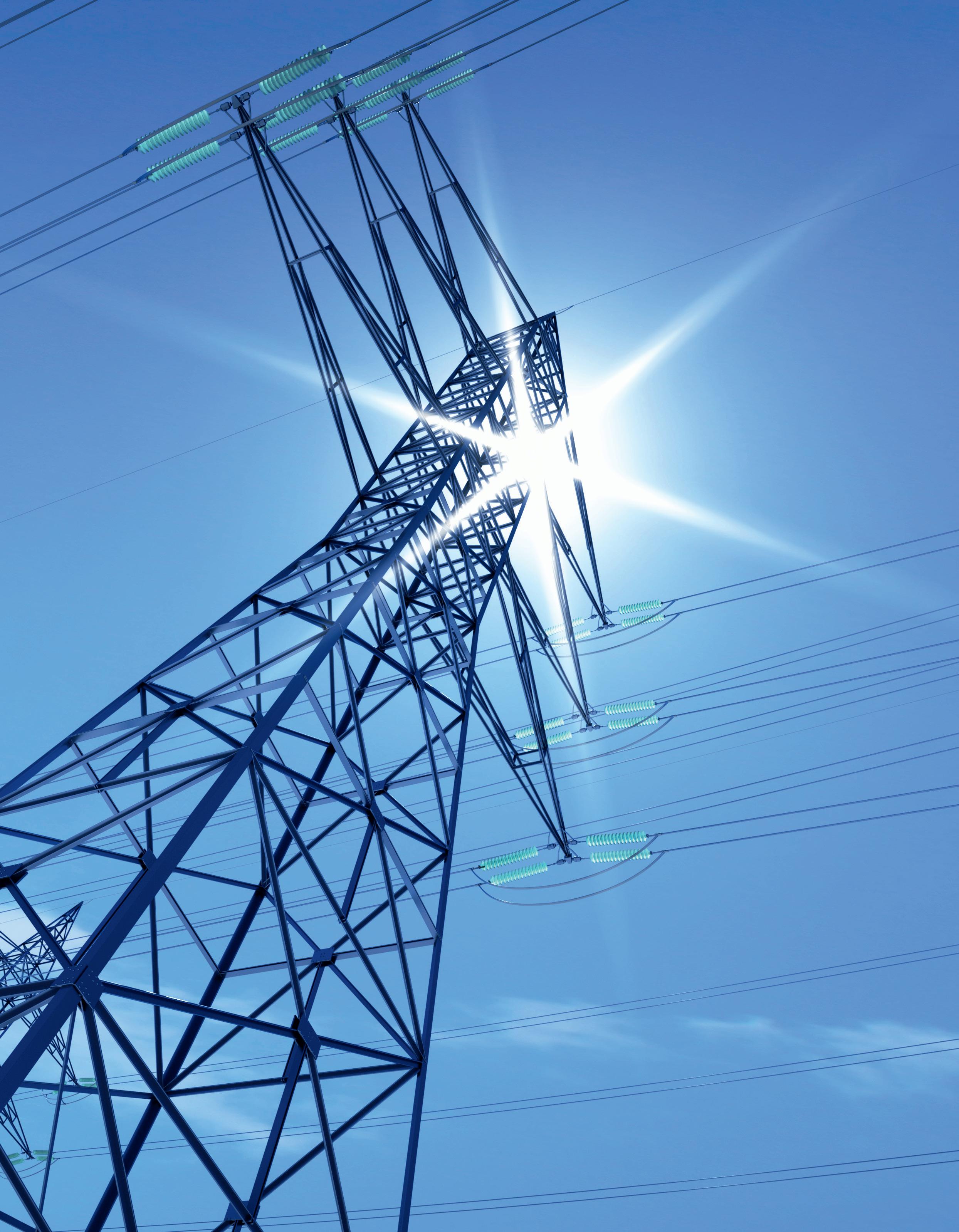
The what and why behind FERC’s rejection of AWS and Talen’s behind-themeter agreement
Zachary Skidmore Senior Reporter - Energy and Sustainability
In March 2024, AWS made headlines with the acquisition of the 960MW Cumulus data center in Luzerne County, Pennsylvania, from Talen Energy. The deal was not just another major data center acquisition; unbeknownst to the sector, it was set to have wide-ranging implications on how data centers are powered.
As part of the acquisition, the companies signed a behind-the-meter agreement that would have delivered 480MW of power directly to the data center from the 2.5GW Susquehanna Nuclear Power plant, located adjacent to the facility.
What followed, however, was a regulatory standoff that would make waves across the energy and data center markets, sparking unanswered questions about how regulators and utilities can best manage the explosive growth of powerhungry AI and cloud infrastructure.
Behind-the-meter
Unlike a grid-based or front-of-themeter agreement, a behind-the-meter agreement involves power being supplied directly to an installation via a direct connection, known as a “private wire.”
As a result, behind-the-meter agreements bypass the main electricity meter for some or all of the consumer's power needs. For data centers, this can be especially beneficial, resulting in reduced energy costs, a faster connection time, and a more reliable source of energy.
While there have been many instances of behind-the-meter agreements in the data center sector, the AWS-Talen agreement differed in both scale and choice of energy. Unlike previous instances, often utilizing onsite renewables, the AWS deal involved a regional key generation asset, which provides consistent and reliable power to the grid.
As a result, to secure the go-ahead, PJM Interconnection, the regional transmission operator in charge of the utility services in the state, had to apply for an amendment to the plant's existing Interconnection Service Agreement (ISA), permitting the increased power supply.
However, rather than the swift approval the companies hoped for, two major utilities that operate in the region, Exelon and American Electric Power
(AEP), vehemently opposed the amended ISA, submitting a formal objection to its provisions.
Exelon chief operating officer Michael Innocenzo revealed the rationale behind the opposition, stating: “Our main concern [was] that colocation shouldn’t be a way to bypass distribution or transmission charges. These facilities still rely on the grid, and we’ll need to invest in upgrades to support them, whether they’re inside or outside the fence.”
Due to the protest, the ISA proposal was escalated to the Federal Energy Regulatory Commission (FERC), which in November 2024 rejected the amended ISA in a two-to-one vote, stating that the parties did not make a strong enough case

“One of the worst things regulators can do is become a bottleneck for innovation. That’s what concerned me most. The PJM case could have been a learning moment. Instead, we missed a chance to get ahead and evaluate colocation in a realworld context,”
>> Willie Phillips
to prove why a special contract should be allowed in this instance.
“The burden is on PJM to show that nonconforming provisions are necessary, and PJM failed to carry that burden,” read a FERC statement at the time.
FERC reaffirmed its decision in April 2025 after a rehearing request from Talen, ultimately scuppering the agreement, leading to the companies having to explore further options. The implications of the FERC ruling are notable in setting a high legal bar for future behind-themeter deals. But, despite the ruling, debate continues over why such barriers exist, highlighted best by then-chair of FERC Willie Phillips, who, amongst his peers, was the only dissenting voice, voting in favor of the amended ISA.
A missed opportunity?
The denial by FERC of the AWS-Talen deal was rooted in the belief that the parties involved did not make a strong enough case to prove why a special contract allowing for expanded “behindthe-meter” power sales should be permitted.
For Phillips, however, the case was never about approving the “perfect scenario” for colocation, but rather an opportunity for a test case of how colocation could function in the future.
In his support of the ISA, Phillips contended that it
would have provided the ability for the generators, consumers, and broader regulatory community to better understand the potential of colocation, acting as a “pilot” for more flexible load models, which he considers a necessity to meet the staggering demand of data center growth.
“I saw the PJM case as a one-off opportunity to pilot colocation. We could have required updates on reliability risks, encouraged targeted investment, and learned from how it performed,” Phillips says.
In his statement explaining his dissent, Phillips went on to contend that, rather than just providing free rein, as feared by objectors, he would have ensured that PJM submitted regular informational filings to provide transparency into the arrangement’s operations over time.
In addition, he said that the deal would have allowed PJM to go through a further stakeholder process for tariff revisions and decide on generic next steps. Therefore, by rejecting the ISA, Phillips argued that FERC essentially “rejected protections that the interconnected transmission owner says will enhance reliability while also creating unnecessary roadblocks to an industry that is necessary for US national security.”
The centrality of data centers as a “national security asset” clearly played in the mind of Phillips in his decisionmaking. Data centers, after all, are some of the most sought-after infrastructure for national governments, due to their ability to attract capital and expertise to a nation's coffers.
In turn, Phillips believed that regulators should seek to support the sector through novel deals, as the skyrocketing demand offered an opportunity to act as “a catalyst to modernize and upgrade our transmission system” and support the projected demand growth across the country.
Consequently, Phillips' decision centered greatly around the notion of whether regulators should act as a roadblock or a facilitator of change. “One of the worst things regulators can do is become a bottleneck for innovation,” he says. “That’s what concerned me most. The PJM case could have been a learning moment. Instead, we missed a chance to get ahead and evaluate colocation in a real-world context.”
The learning moment could also have
supported greater alignment between the regulators, which all play a crucial role in the process. Made even more important due to the scale and speed of demand growth emanating from the sector, at a rate “not seen since the Industrial Revolution,” Phillips continued.
Therefore, for Phillips, the lack of regulatory clarity within the industry as it pertains to how to power these massive facilities is proving a thorn in the side of progress, which in turn hurts planning procedures that could provide a streamlined process for large load connections while avoiding the worst impacts, namely shifting costs onto consumers.
Pay for play
The issue that ultimately scuppered the AWS-Talen deal was the notion that the companies, via a private wire, were shirking the responsibility to pay their fair share of infrastructure costs to upgrade the network.
As Michael Innocenzo puts it, it was never a problem with the idea of colocation itself. “To set the record straight, we’re not against colocation in any way,” he says. “If a large data center can colocate with a generator and get online faster, we fully support that.”
Instead, Exelon and AEP sought to ensure that “colocated facilities still use grid services and should not be exempt from paying for them. They are network
“We need regional coordination, and I would support a national plan to integrate generation and transmission for data centers. They’re not like other loads— they’re something entirely new, and we have to plan accordingly.”
>> Willie Phillips
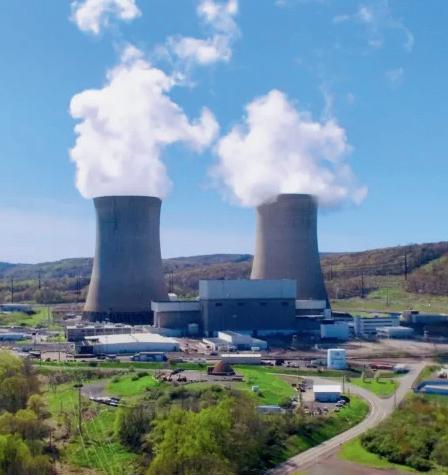
load and should be treated accordingly,” Innocenzo argues.
The companies refuted the claim made in the proposal that colocation would remove all grid impact. Arguing that even if the load directly connects to the generator, the generator is still reliant on the grid itself for stability and voltage regulation. Under current US laws, the generator is not expected to pay for these grid services, with the load user (ratepayer) footing the bill. However, under the proposed ISA, AWS, as the ratepayer, would avoid the responsibility to foot the bill.
Therefore, for Exelon and AEP, it was all a “matter of affordability,” says Innocenzo, as while the companies want to support data center growth, they also want to avoid “shifting costs from high-usage customers onto residential ratepayers.”
This is an issue that Phillips agreed upon, viewing the importance of affordability as “critical.” However, he argued that this falls on the regulators to ensure proper planning and create provisions to prevent cost shifting onto residential and industrial customers who already fund the grid’s backbone.
What is even more crucial is wholesale investment in transmission and distribution infrastructure to meet the expected demand. Here is where Phillips has some concerns: “You don’t want a situation where investment in AI infrastructure outpaces the investments we need in transmission and generation. That’s where we risk falling behind.”
As a result, we are increasingly seeing utilities and state legislatures bring forward new rules on large-load customers and their contribution to
“To set the record straight, we’re not against colocation in any way. If a large data center can colocate with a generator and get online faster, we fully support that,”
>> Michael Innocenzo
funding grid infrastructure projects. Notable recent examples include Oregon, which recently passed a bill that would provide regulators the ability to ensure that data centers and other large loads cover a fair share of the costs associated with new power plants and transmission lines used to power their installations.
New Jersey and Ohio have also proposed similar bills to ensure this, marking a prevailing trend of regulators seeking increased protections for ratepayers over who bears the costs of generation and distribution.
Is this the end for behind-themeter?
Since the rejection by FERC, Talen and AWS have reimagined the agreement, with it moving from behind to an infront-of-the-meter arrangement. The 17year PPA will see Talen supply AWS with 1.92GW of power, ramped up over the next seven years, with the power provided through PJM. This reflects a broader move within the sector, with both Talen and nuclear energy generator Constellation

indicating their intention to focus on grid-based arrangements going forward.
Despite this, Phillips still believes that under the correct circumstances, colocation can be a powerful tool, especially for AI and hyperscale cloud deployments seeking to scale quickly. To ensure this is done effectively, however, Phillips contends that modernization is required across the broader regulatory landscape.
Phillips cited the 206 proceedings ordered by himself in February as a reflection of this urgency for reform, which he says could force through faster timelines for decisions on matters such as colocation. The proceeding aims to address regulatory gaps in how co-located large loads, particularly AI-driven data centers paired with on-site generation, are governed under the PJM Tariff.
In the current proceeding, FERC is evaluating whether PJM’s current rules are unjust or unreasonable and whether new provisions are needed to ensure transparent, nondiscriminatory treatment of co-located load configurations. The ultimate goal is

to provide regulatory certainty, support infrastructure investment, and ensure grid reliability amid a sharp rise in largescale data center demand.
“What I liked about the 206 proceeding is that it boxes FERC in - it says, you have six months. You can’t take two years. And I’m hopeful we’ll get regulatory certainty from FERC very soon,” says Phillips.
As a result, while colocation appears to be very much on the back burner, it is unlikely to disappear completely, especially as data center growth continues.
A rallying call
While the future of behind-the-meter agreements, especially for large hyperscale facilities, remains uncertain, Phillips contends that what's key now is developing a clear and consistent regulatory regime to ensure that the concerns voiced over colocation, namely, costs falling on ratepayers, are accounted for.
Consequently, for Phillips, a key factor in supporting colocation is greater coordination and planning across federal and state bodies. “This can’t be business as usual,” he argues. “We need regional coordination, and I would support a national plan to integrate generation and transmission for data centers. They’re not like other loads—they’re something entirely new, and we have to plan accordingly.”
Subsequently, Phillips stated that “If I were still a regulator, I’d focus on three things: reliability, affordability, and boldness. We can't wait for a crisis before acting. We must lead—be proactive, not reactive— and lay the foundation for this next era of energy transformation led by data center demand.”
Beyond uptime: Why power quality is the unsung hero of the AI-driven data center
SVP of digital power business at Schneider Electric, Arnaud Cantin, explores why it’s not enough to source more power for the AI era – but power fit to fuel the data center machine
DCD: The data center industry is experiencing an unprecedented boom, largely driven by the rapid growth of AI. While much of the conversation focuses on capacity and cooling, you’ve been a vocal advocate for a topic that's often overlooked: power quality. Why is this so critical right now?
Arnaud Cantin: It’s a crucial conversation. For years, the industry has rightly been obsessed with uptime – with Tier ratings and redundancy as the gold standards. We’ve mastered the art of keeping the lights on. But the nature of the load is changing dramatically.
Think of an AI data center not as a building, but as a Formula 1 (F1) engine. For years, we focused on ensuring it always had fuel (uptime). But now, the performance is so high that the quality of the fuel (power quality) is paramount.
You wouldn't put dirty, low-octane gas in an F1 car and expect to win. The relentless surge of AI, with its demand projected to grow at a staggering CAGR of 25-33 percent through 2028, puts an entirely new kind of stress on our electrical infrastructure. The greatest threat to resilience today may not be a complete blackout, but the constant, insidious degradation of power quality, and consequently noncompliance with grid codes.
We saw a case with a hyperscaler where a minor, sub-cycle voltage sag from the utility – far too short to trigger the UPS – was enough to cause data corruption across a whole rack of GPUs running a critical AI training model.
There was no outage in the traditional sense, but the cost to restart the multi-day
training job and the potential for flawed results was in the seven figures. That’s the insidious nature of this problem. In this new era, focusing only on uptime is like building a fortress but ignoring the quality of the water or air. It’s a fundamental vulnerability.
DCD: That’s interesting. Most operators are focused on the grid coming in. Are you saying they're creating a significant part of the problem themselves? How can a brandnew, high-tech server be 'dirty' from an electrical standpoint?
Arnaud Cantin: Certainly. It's a twosided challenge. On one side, you have the external grid. With the increasing integration of intermittent renewables and the rising frequency of extreme weather events, the power being delivered to a facility's doorstep is less stable than ever.
This is the contaminated fuel being delivered from the pump. Power quality issues are now the most common cause of major outages. On the other side, you have an internal threat that the data center creates itself. The very components that power AI – high-density server racks, advanced GPUs, and modern cooling systems with EC motors are non-linear. These loads are sensitive to external voltage fluctuations (sags/swells) and at the same time generate significant electrical noise in the form of harmonic distortions, which contaminates the facility's network, leading to overheating, premature equipment failure. In our F1 analogy, this is like sludge building up inside the engine itself, created by its operation, reducing efficiency and causing wear.
DCD: This internal pollution doesn't just
stay within the data center walls, does it? This is where the conversation turns to compliance.
Arnaud Cantin: Exactly. Data centers are no longer just passive consumers of energy – they’re significant players on the grid, accounting for up to three percent of global electricity consumption. This internal electrical noise travels back out, and utilities are taking firm notice.
Grid codes, like IEEE 519 in North America and EN 50160 in Europe, are no longer simply recommended, but are being enforced with increasing stringency by

In the AI era, mastering power quality isn't just about defense – it's a competitive advantage
>> Arnaud Cantin, Schneider Electric
utilities across the globe. Operators who fail to keep their harmonic distortions in check are no longer just risking their equipment; they are facing significant financial penalties for destabilizing the local grid. Being a good grid citizen is now a matter of both operational necessity and financial prudence.
DCD: Let's be frank, this sounds complex and potentially expensive. For an operator who hasn't experienced a major power quality failure yet, how do you justify the upfront investment in advanced monitoring and active filters? Why isn't a top-tier UPS and a generator enough anymore?
Arnaud Cantin: That’s the critical question. A UPS is essential, but it is not a panacea for all power quality issues. To build a truly resilient electrical architecture, we need a modern, multi-layered defense. The first step is to see the invisible. You cannot fix what you can't see.
Advanced, Class A power quality meters installed at key points provide the highresolution visibility needed to diagnose these issues in real-time. These meters follow strict international standards that define precisely how measurements are taken – using consistent, validated algorithms – so you can trust the data when making critical decisions.
DCD: That brings us to the crucial first step. Before you can even begin to "see the invisible" or "cleanse the power," you need accurate data. How does robust power metering lay the essential groundwork for achieving better power quality in a data center?
Arnaud Cantin: Absolutely. Think of power metering as the vital diagnostic system for our F1 engine. Without it, you're driving blind. High-resolution, granular power metering at various points – from the utility incoming feed to main distribution panels, down to individual racks and even specific critical equipment – provides the foundational data.
It's not just about energy consumption for billing – it's about understanding the nuances of current, voltage, frequency, power factor, and crucially, harmonic distortion levels. By continuously monitoring these parameters, we can establish baselines, identify deviations from ideal sine waves, pinpoint the exact source of internal electrical noise, and detect subtle external grid disturbances that might otherwise go unnoticed by a
standard UPS.
This detailed, real-time data is indispensable for diagnosing power quality issues, trending performance over time, and validating the effectiveness of any mitigation strategies. In essence, comprehensive power metering transforms a reactive approach to power quality into a proactive, data-driven strategy, allowing operators to make informed decisions and truly master their electrical ecosystem. But seeing the problem is only half the battle. You must actively cleanse and correct the power.
DCD: This is where solutions like Schneider Electric’s AccuSine range come into play. How do they specifically address that compliance challenge?
Arnaud Cantin: This is precisely where we focus our innovation. Once you've identified harmonic distortion, you need to eliminate it. Our PowerLogic AccuSine PCS Plus Power Correction System acts like noise-canceling headphones for the electrical system. To use our engine analogy, it’s the sophisticated fuel filtration system that cleans out the sludge in realtime.
They dynamically monitor the network and inject an opposing current to cancel out the harmonic distortions created by the IT loads. This ‘cleanses’ the power, which not only protects sensitive downstream equipment and improves overall efficiency but, crucially, ensures compliance with utility grid codes.
The PowerLogic AccuSine PCS Plus Power Correction System is a direct response to this challenge, giving operators the tool they need to mitigate harmonics at the source and avoid those costly penalties from utilities. It’s about moving from a passive to an active stance on power quality.
DCD: So the AccuSine range is about actively ensuring you're not polluting the grid, while other solutions protect you from the grid's instability?
Arnaud Cantin: A perfect summary. You use a solution like the PowerLogic AccuSine PCS Plus Power Correction System to ensure your facility is a responsible grid citizen. Then, to shield yourself from external grid volatility, you can deploy a Dynamic Voltage Restorer (DVR) for brownout conditions.
A DVR sits at the front end of a facility and acts as the ultimate shield, instantly
correcting for voltage sags and swells without ever engaging batteries. It ensures a perfect sine wave reaches your critical load, regardless of fluctuations from the grid.
DCD: It seems the final piece is bringing all this information together
Arnaud Cantin: Precisely. The final layer is a sophisticated power management system. A platform like our EcoStruxure Power Operation aggregates data from all the monitoring devices and mitigation equipment into a single pane of glass.
This allows operators to shift from being reactive – chasing phantom failures after they occur – to being proactive. They can use analytics to spot negative trends, validate that their AccuSine filters are ensuring grid code compliance, and continuously optimize the health and efficiency of their entire electrical infrastructure.
DCD: To conclude, what is your key message to data center operators navigating the AI era?
Arnaud Cantin: Ultimately, operators are at a crossroads. They can continue to react to a power environment that is fundamentally changing, treating these phantom failures as the cost of doing business. Or, they can become active masters of their electrical ecosystem.
In the AI era, mastering power quality isn't just about defense – it's a competitive advantage. The winners will be those who ensure the health of every single watt. The conversation has moved beyond uptime –it’s now about the holistic health of your power.
To learn more about Schneider Electric’s power quality solutions, visit the website. You can download Schneider Electric’s latest e-guide about power quality for data centers here
From Years to Months: Creating an AI fast lane for grid connection


DCD gets the inside track on how GridCARE is using AI to find extra capacity across the grid
The University of Stanford has long been a breeding ground for innovation. The university where Google, among others, was founded, remains one of the most fertile grounds for new and exciting companies.
One of the latest to emerge is GridCARE, which formally launched earlier this year following the successful raise of $13.5 million as part of its seed funding round. The company, born out of Stanford's Sustainability Accelerator, aims to address one of the biggest bottlenecks facing the data center
industry today: time-to-power. To do so, it is leveraging one of the fruits of the sector's unprecedented growth, artificial intelligence.
The company has launched a generative AI platform, which it claims can unlock untapped capacity across the US grid, enabling developers to secure reliable power at a fraction of the time and cost, without having to wait for costly transmission upgrades.
DCD spoke with its cofounder and CEO, Amit Narayan, to learn more about how GridCARE is using AI to make grids more flexible and intelligent in the face
of increasing uncertainty about whether current infrastructure can manage the exponential growth of the data center sector.
Myth Buster
GridCARE was founded on the realization that while the US power grid is almost universally perceived to be heavily constrained, the reality is actually much more nuanced.
According to Narayan, on average, the US grid only operates at about 30 to 40 percent of its maximum utilization capability, meaning that there is
Getty Images
Zachary Skidmore Senior Reporter - Energy and Sustainability
significant untapped capacity that could be unlocked through more intelligent analysis and planning. The founders of GridCARE saw an opportunity brewing to “take the latest advances in generative AI and apply it to improving the power grid,” according to Narayan.
In doing so, the company believes that it can bust a few of the myths of grid constraints, which it says are predominantly the result of outdated assumptions and conservative planning practices.
At present, grid planning typically looks at worst-case scenarios such as multiple outages on high-temperature days and assumes those conditions are persistent across the year. This creates a perception that the grid is constrained when, in reality, constraints are often only present under very narrow and infrequent conditions.
Narayan points to the California grid as the perfect example of this, arguing that it is only constrained during peak hours, with no problems at night or during the winter. GridCARE discovered that there is a significant amount of latent capacity
available on the grid, which is not considered by planners, who fail to take into account operational controls and technologies that are already in place.
Therefore, through the use of generative AI, which considers all the tools and technologies on the grid, GridCARE can simulate and validate its effectiveness under real-world conditions, which it says can significantly accelerate connection timelines and unlock hidden capacity that doesn't typically reveal itself in the utilities analysis.
Increased flexibility
GridCARE is approaching the power issue with flexibility as a central tenet, with AI seen as the perfect tool to unlock greater flexibility across the grid. Its solution works through the use of generative AI and advanced scenario modeling, which identifies geographically and temporally specific constraints and proposes targeted, cost-effective bridging solutions.
The solution is able to analyze hundreds of thousands of possible grid scenarios and pinpoint exactly when and where congestion occurs, allowing for better

“We want to remain neutral, like a TSA PreCheck. We help developers and utilities move faster by creating a trusted “fast lane,” following utility standards, and only challenging assumptions when it’s justified.”
>> Amit Narayan, CEO GridCARE
planning and understanding of where new capacity can be added to the grid. These include leveraging existing tools like demand response programs, battery storage, and microgrids more effectively to free up extra capacity on the grid.
Through its solution, the company seeks to support utilities that have access to operational tools like battery storage and demand response, but have not factored them into planning. In addition, it works directly with data center developers, from major hyperscalers to AI data center developers, to accelerate timeto-power for infrastructure deployment, both for upgrading existing facilities and identifying new sites with immediate power availability for gigascale AI clusters.
The impact of this can be staggering in terms of reducing the waiting times for a connection, says Narayan, with data centers that usually would have to wait between five to seven years for a connection, seeing time to power slashed to potentially six to twelve months.
“We don't just model constraints—we also map what assets are available to relieve those constraints in real time,” Narayan says. “By combining grid data, asset visibility, and scenario modeling, we’re able to surgically unlock capacity— even in regions where traditional thinking says nothing is possible for the next five to seven years without building new infrastructure.”
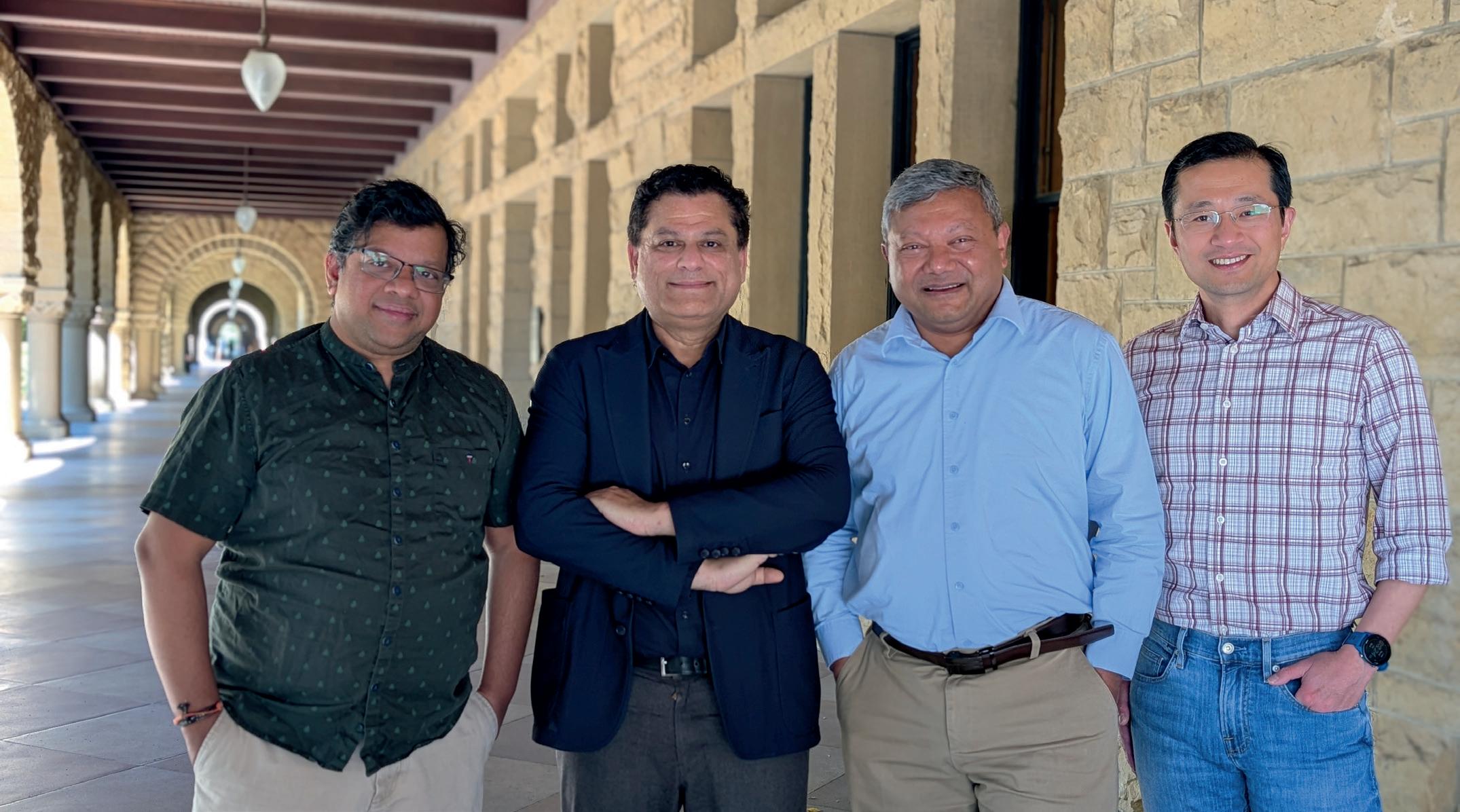
According to Narayan, GridCARE’s solution has already seen “tremendous interest from data centers across the spectrum.” This interest is not only confined to the major hyperscalers, with data center operators focused on inference in a prime position to take advantage of the solution, due to their inherent flexibility, both geographically and temporally. This means that they can be sited in areas with a smaller footprint, which will expedite their time to power.
In addition, the solution offers significant financial benefits for the data centers themselves. This is especially true for AI data center developers, where revenue is greatly impacted by power availability, with the typical estimate being about $10,000 of lost value per megawatt per day of delay.
Narayan notes that this tends to add up quickly, as for a “100 to 200MW project, you're talking about hundreds of millions or even billions in potential value. Therefore, our technology doesn’t just help them find power, it helps them accelerate time to revenue and reduce the need for expensive new builds by better utilizing the assets we already have.”
Acting as the middleman
Despite its clear focus on reducing time-
to-power for data center developers, GridCARE has positioned itself as a “trusted, neutral third party” between the data centers and utilities that serve them, says Narayan.
As a result, GridCARE is not only partnering with data center providers but also the utilities themselves. It has already signed partnerships with Portland General
“At present, utilities don’t report utilization or queue backlogs. Just measuring those would be a great first step. And studies have shown that modest flexibility, such as a battery, demand response, or a virtual power plant, can unlock significant capacity,” >> Amit Narayan
Electric and Pacific Gas & Electric, which view the solution as a means to better utilize their grid assets, as a means to increase overall revenues, and bring down the costs of electricity.
“Collaborating with GridCARE and using advanced planning tools enables Portland General Electric to make more informed and faster decisions in bringing this critical infrastructure online with confidence,” said Larry Bekkedahl, SVP of advanced energy delivery at Portland General Electric.
Therefore, like Switzerland, neutrality is embedded in GridCARE’s approach, which in turn will allow for greater flexibility to support not only data centers, but any large load seeking an expedited connection to the grid.
“We want to remain neutral, like a TSA PreCheck. We help developers and utilities move faster by creating a trusted “fast lane,” following utility standards, and only challenging assumptions when it’s justified,” says Narayan.
In acting as a middleman, GridCARE hopes to improve communication between the different stakeholders, which Narayan accepts is poor, which has led developers to view utilities as blockers, and utilities to consider developers with trepidation, unsure whether their
proposal is serious or speculative. Therefore, in acting as a middleman between the two, both sides are provided greater clarity on when power can likely be delivered, removing the sense of distrust that has become prevalent throughout the industry.
In positioning itself as a middleman, GridCARE has also developed a somewhat unique business model, with the company being paid for every successful transaction that happens between the utility and the developers. Therefore, as Narayan contends, GridCARE has skin in the game, meaning that it is extra incentivized to see results.
Regulatory landscape and US focus
For Nayran, the “secret sauce” of the company is the fact that it works within the existing regulatory regime, meaning that its deployment is not dependent on any major policy change from the Federal Energy Regulatory Commission (FERC) or the North American Electric Reliability Corporation (NERC).
Despite the secret sauce, Narayan argues that greater transparency across the regulatory landscape would still make a significant difference, especially on the side of utilities. Currently, utilities do not typically report utilization or queue backlogs, which significantly hinders the ability to understand how modest flexibility, in the form of a battery or virtual power plant, could unlock significant flexibility across the grid.
As a result, if this flexibility were factored into grid studies, and especially if the public utility commissions required it, it could create much greater urgency within the sector to support solutions such as GridCARE’s.
For the foreseeable future, GridCARE is focusing all its energy on the US market, due to the size of the country’s data center sector and massive load growth projections. The company plans to focus predominantly on regions facing the most acute capacity bottlenecks, including California, Texas, and the Northeast. However, grid constraints are not simply a US issue, but one that is wreaking havoc across the globe.
Therefore, while GridCARE will continue to focus on the US market, it contends that all its solutions are globally
“We don't just model constraints—we also map what assets are available to relieve those constraints in real time. By combining grid data, asset visibility, and scenario modeling, we’re able to surgically unlock capacity— even in regions where traditional thinking says nothing is possible for the next five to seven years without building new infrastructure,”
>> Amit Narayan
applicable. Narayan revealed that even without a proactive marketing campaign, it has seen interest from across Asia, the Americas, and the Middle East. Therefore, if the company can demonstrate success in the US market, there is the potential for global expansion down the line.
No time for a grid connection
The ultimate goal for GridCARE is to create a system where grid connection time is reduced to zero, effectively
removing the bottleneck of time-topower.
“We want to go to a point where there is no wait for getting connected to the grid,” says Narayan.
The goal is very ambitious, given the current state of the US grid and the huge projections of load growth from the data center sector alone. To achieve this, Narayan says that GridCARE is seeking to redefine how grid capacity is understood, planned, and utilized, using the current infrastructure more intelligently.
“We’re not just a technology company—we’re helping to shift mindsets. We’re challenging assumptions that no longer reflect today’s reality,” says Narayan.
GridCARE is not the only firm exploring the use of AI in this regard, with several companies emerging in 2025 alone promising significant cuts in grid connection through proprietary AI tools.
Several companies have launched or signed deals seeking to deliver similar reductions in grid connection times through AI. Most notably, Google X's moonshot project Tapestry, which signed a deal with PJM Interconnection to manage its interconnection queue and automate processes currently completed by grid planners, ultimately seeks to create a model of the grid, akin to Google Maps.
Therefore, we are seemingly on a precipice, like many other sectors, where AI companies are offering solutions that could revolutionize the way we interact with some of the most critical infrastructure. As a result, we could be getting closer to a day where time-topower no longer represents one of the biggest bottlenecks for data centers on their route-to-market.
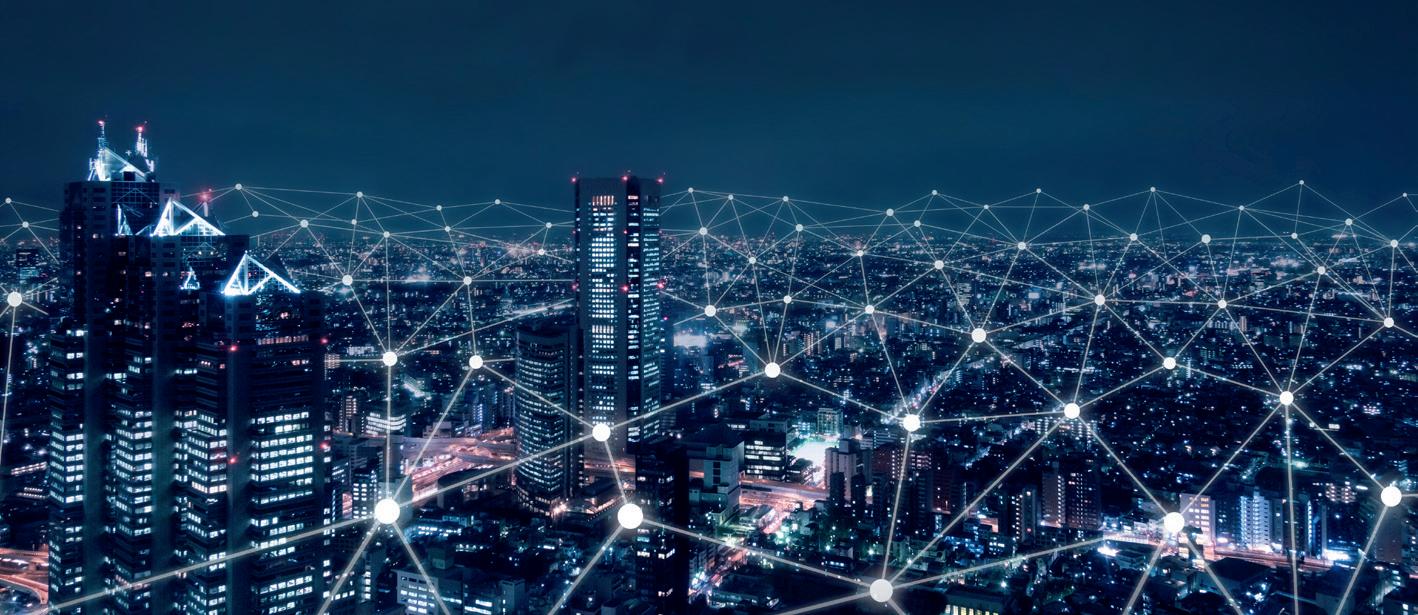
Go with the flow
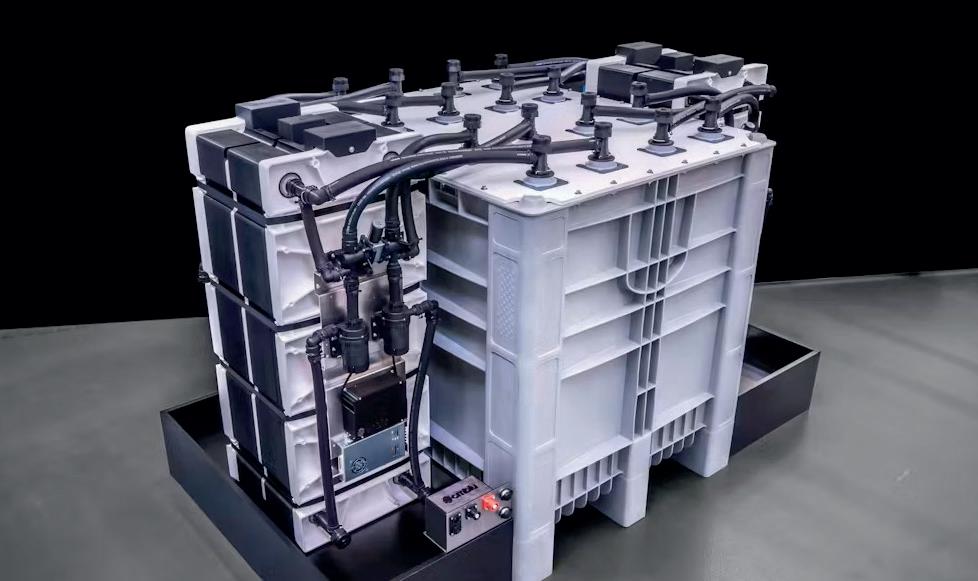
Are flow batteries the answer to the energy storage needs of data centers?
The soaring energy demands of data centers in the AI era have rapidly become one of the biggest headaches for executives in the industry.
Not only are racks getting denser and more power-hungry than ever before, but they are doing so against the backdrop of an energy grid that is, in many parts of the world, transitioning away from fossil fuels towards more sustainable sources of power.
Renewables, by their nature, are less consistent than fossil fuels when it comes to supplying energy, so battery energy storage systems, better known as BESS, are being delivered at many new data center developments. These systems collect and store energy at times of surplus, meaning it can be redirected to a data center - or back into the wider gridat times when the wind drops or the sun isn’t shining.
But while the benefits of BESS are well established, the type of battery that should sit at the heart of these systems remains up for debate. Cells based on the lithiumion chemistry currently dominate the market, but for large-scale installations, these can be problematic. Damaged lithium-ion batteries can cause fires or explosions, while geopolitical tensions between China and the US mean getting hold of the materials required to make them in the first place is a challenge.
In this context, businesses and researchers are looking to other chemistries, and flow batteries, a type of cell that doesn’t rely on lithium, could prove to be a winning formula if challenges around its adoption can be overcome.
Everything must flow
Flow batteries differ from conventional

Matthew Gooding, Senior Editor
cells because they use a liquid electrolyte to store energy, rather than a solid material.
“You have two tanks, one positive and one negative, with the charged storage material dissolved into a liquid,” explains Tom Sisto, CEO of XL Batteries, which makes grid-scale flow batteries. “From those tanks it's pumped through the cells, and as it flows over the electrodes, it does the charging and discharging goes back into the tanks.”
With a flow battery, you can scale up the size of the storage tanks without needing a corresponding increase in energy, so in theory, they make an ideal storage option for squirreling away excess power. The technology has been around for years, but the liquids used in the electrolyte have traditionally been quite problematic.
“Vanadium is the classic one, which is a highly mature technology that has been scaled for grid use,” Sisto says. These batteries use vanadium ions as the charge carrier, and Sisto explains: “Vanadium is expensive and found in geopolitically sensitive regions like Russia and China specifically, and it only dissolves in sulfuric acid. This means the electrolyte
solution of vanadium and sulfuric acid is very caustic and drives a lot of component costs within the device.”
XL Batteries’ solution is to use an organic compound dissolved in pHneutral water. Its technology is based on research from Columbia University in New York, where the company’s cofounders discovered organic molecules that are stable in both charged and discharged states, making them suitable for incorporating into a battery.
Vendors of flow batteries claim they offer significant advantages over lithiumion for data center operators looking to install a BESS, the chief one being that the likelihood of water-based cells catching fire is, for obvious reasons, fairly remote.
“The safety aspect is really important for the data center folks,” says Giovanni Damato, president of the US division of CMBlu Energy, which manufactures what it calls an organic solid flow battery, using a water-based electrolyte. “I think everyone's concerned that their batteries do not have thermal runaway events in the communities where their data centers are located. Our technology doesn’t have that risk.”
Thermal runaway can occur when a lithium-ion battery becomes old or damaged, and leads to the temperature of the battery increasing rapidly, running the risk of fires or explosions.
Away from safety, flow batteries could also be more cost-effective and efficient than lithium-ion for long-duration storage, which the US Department of Energy classifies as ten hours or more. “In the eight-to-ten hour storage range, our prices are comparable to lithium-ion right now at low volume,” Damato says. “As we scale up and can buy materials in bulk, we’re going to see that price drop.
“The other benefit for the type of loads required in data centers is that we can cycle a lot. Our batteries don’t degrade based on cycling like lithium-ion does. It's more of a steady calendar life degradation, so you’re looking at a 10-15 year lifespan before you have to refurbish the battery.”
Shock absorbers
With plenty of potential benefits, it’s no surprise data center operators are looking at liquid flow batteries as part of their energy solutions.
“The safety aspect is really important for data center folks,”
>> Giovanni Domato
XL Batteries has agreed to a partnership with Prometheus Hyperscale, which will see batteries deployed at the company’s data centers over several phases. In the initial phase, XL will supply and install a 333kW demonstration-scale, standalone Organic Flow Battery at an undisclosed Prometheus site in 2027. Following this, Prometheus plans to acquire a 12.5MW/125MWh commercial-scale system in 2028, with another identical system to follow in 2029.
“We fit a lot of use cases, but for Prometheus specifically, we’ll be used as a ‘shock absorber’ for large compute power swings,” Sisto explains, referring to the wildly varying power draw of GPUs, which DCD reported on in April. “So as they ramp power up and down very quickly, we’ll be there as a buffer.”
Sisto believes the technology will be useful, not only for storing energy from intermittent sources of energy like renewables, but also for “flat” energy generation technologies like small modular nuclear reactors, which are expected to be deployed in data centers over the coming decades.
“You don't shift nuclear power generation quickly,” he says. “So storage allows you to match the variability of demand with a flat line of generation.”
CMBlu’s technology is being deployed at a DataHall data center in Saale, Germany, which is set to come online in 2027/28. It will initially feature a 4MW battery, with the
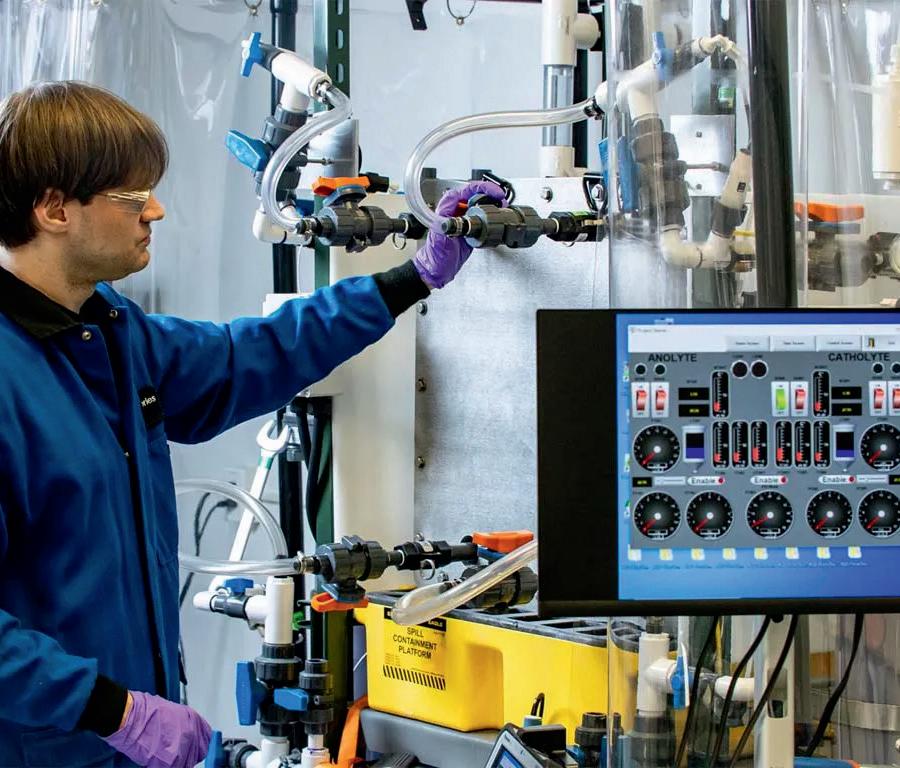
aim of expanding to 50MW.
“We’ve got a few customers in Europe that we’re working with because they’re facing specific local constraints around electricity supply and pricing, and want a battery on site,” Domato says.
Challenges ahead
While flow batteries show great promise, issues around scaling the technology remain.
Last year, Australian vendor Redflow Batteries went into voluntary administration, having failed to secure investment for its flow battery, which used a liquid electrolyte combined with zinc-bromide in what Redflow claimed to be an environmentally-friendly solution.
Despite receiving multiple government grants, and landing a contract to supply 15.4MWh of batteries for a microgrid in California, it said it had been “unable to attract the required equity support” to continue, and administrators were unable to find a buyer, demonstrating some investor reticence around the potential of the batteries.
With lithium-ion being such a wellproven technology, Domato admits flow batteries still have a way to go before they are used widely in data centers and beyond.
“Lithium-ion has taken 60 years to get where it is today,” he says. “We’re getting close to a full commercial roll-out [for flow batteries], but it’s going to take a lot of patient capital to keep things moving. We’re in that valley between pre-commercial and commercial, and ramping up is our key challenge right now.”
XL Batteries’ Sisto is confident flow batteries have a role to play alongside other storage technologies as data centers navigate the energy transition. “The global energy market is one of the largest markets in existence,” he says. “The numbers we’re talking about are so astronomical that they’re almost incomprehensible.
“If we’re going to modernize what is the most complex machine in the world, I think it will take everybody, and I am hopeful that the industry and the markets will move together towards a new era of energy generation, storage, and consumption.”


